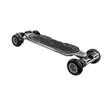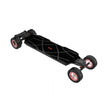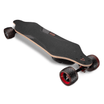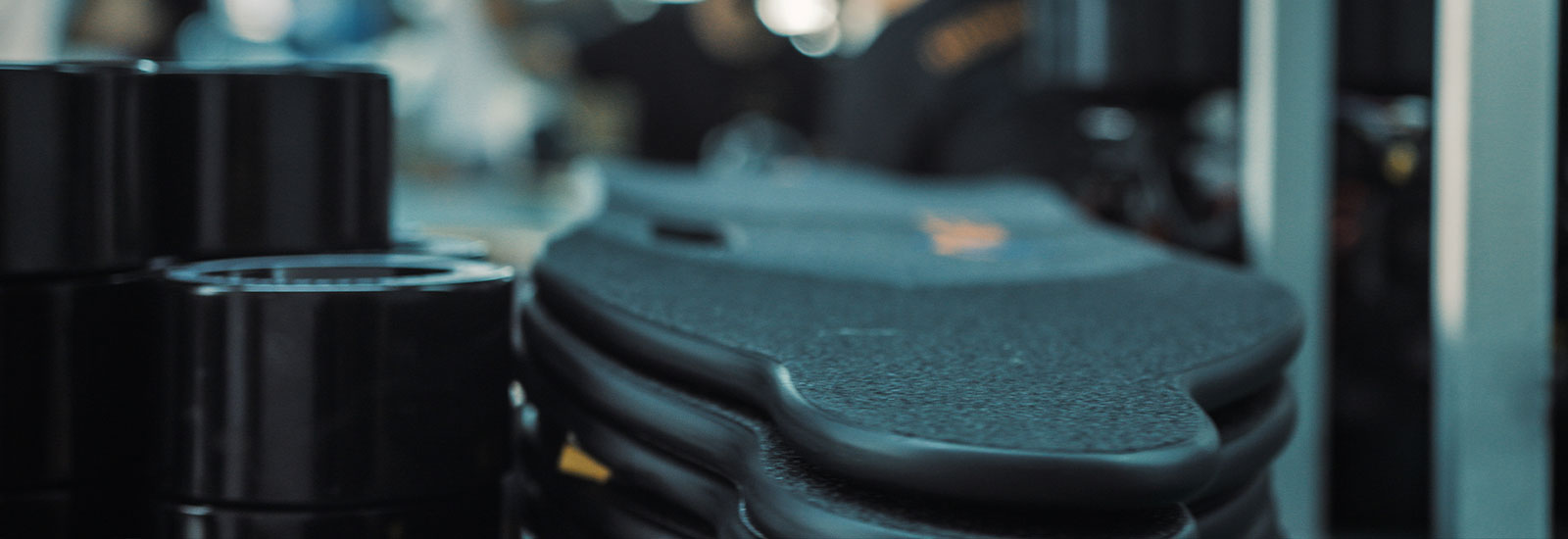Author: Nate Gell
Wear Safety Gear
Wearing safety gear works on two different fronts. For starters, the simple fact that you are a beginner and a little inexperienced means that there is a higher chance of falling off. So wearing safety gear will prevent you from doing any serious damage to your body.
The second is, that by wearing safety gear you all of a sudden become more confident while riding. You’re less worried about falling because if you did happen to fall, you know you’ve got the necessary safety gear to counter the impact.
This is important because you now have one less thing to worry about, which for most people, the fear of falling and getting hurt is their biggest worry. This opens you up to being able to fully concentrate on actually riding your electric skateboard. There are a variety of different options for safety gear for every part of your body. You can get knee pads, elbow pads, wrist guards, gloves, hip pads, shoulder pads, chest pads and back pads. But, if you want to keep it simple, then I would strongly recommend you always wear a helmet. They literally save lives.
Find A Comfortable Stance
Everyone is different, so it’s important to find what works best for you. The first thing about finding your best stance is knowing whether you have a Regular Stance or a Goofy stance. This just means which foot you put forward. In a Regular stance, you lead with your left foot forward. In a Goofy stance you’ll lead with your right foot. If you’re not sure which one you are, here’s a trick you can do to find out.
Stand on the ground, upright with your feet shoulder-width apart. Have a friend place their hand on the middle of your back and gently push you forward with just enough force until you begin to fall over. As you begin to fall over, you’ll catch yourself by stepping forward with one of your feet.
The foot you use to catch yourself with is your dominant foot which will be your front foot. If you caught yourself with your left foot, you’re Regular stance, welcome to the club. If you caught yourself with your right foot, you’re in the Goofy stance crew.
The length of the deck will largely determine how far apart you place your feet on the board. Most commonly, on longboard skateboards, you’ll be placing your feet slightly narrower than where the trucks sit under the board. On shortboards, you tend to place your back foot on the kicktail and your front foot on top of the front trucks.
But, it all depends on the eboard that you’re riding and what feels most comfortable for you.
Lastly, you want to ride with a slight bend in the knees. This will help with your balance as well keep you ready for any unexpected bumps and cracks that you’ll encounter on your ride.
Understand Your Equipment
There are a lot of different components to an electric skateboard. Before you start riding, it’s best to understand what is an electric skateboard and how all of the parts work together to make it move. The first thing you should always do before riding your new electric longboard for the first time is to check your trucks.
More often than not, you’re eboard will have really loose trucks when you pull it out of the box. This isn’t great for first-timers because it makes balancing on the board much harder. You’ll generally be sent a T-tool, which you can use to tighten up the trucks. After you’ve gotten the hang of riding your eboard, you can loosen the trucks to find your optimal ride.
Another thing you want to have a complete understanding of is your remote. Every company has a different remote (usually), so it’s important to know what each button, toggle, switch and the other do-dads do on yours.

Check Your Riding Mode
This might sound like a dumb one, but I can’t tell you how often I’ve jumped on my eboard, hit the accelerator only to realise my eboard was in reverse and been left eating the concrete in front of me. The quick checks I do on the remote are the direction mode (forward or reverse) and the speed mode (slow, medium, fast, GT, etc...). I then lift the motored wheels off the ground and apply the accelerator and brakes to double-check the connection. If everything passes, we’re good to go!
Accelerating
There are three main dimensions to riding an electric skateboard. They are accelerating, braking and turning. Let’s talk about the best way to accelerate safely. You’ll want to start by standing on your eboard in the stance you learned earlier. Then you want to have a slightly bent but rigid back knee and plant it into the rear of your deck. This is where you’ll brace yourself from the force generated from the acceleration. Lastly, you want to bend your front knee and slightly lean forward over your front leg. This will make it easier to combat the power generated from accelerating.
When you apply the acceleration, you want to start out by easing it on slowly. As a first-time rider, you won’t know what level of force will be applied when you accelerate, so it’s always better to stay on the side of caution until you have become familiar with the acceleration of the eboard.
Braking
Braking is literally the opposite of accelerating. So you can apply what you already know about accelerating but in the opposite. Just before you’re about to brake you want to shift your weight onto your back leg. The harder you are going to brake, the more weight you want to shift backwards. Keep your front knee slightly bent but rigid and ease the brakes on until you come to a complete stop. A bonus tip here is, if you bend your knees a little more into a crouch, it will lower your centre of gravity and reduce the amount force that is applied to your body while braking.
Turning
The last of the three main steps to understanding how to ride an electric skateboard is the turning. This is arguably the hardest aspect of riding an electric skateboard. But don’t fear, because I’m going to break it down for you step-by-step. The way you turn left and right is by shifting your weight between your heels and toes. This is called turning heelside and toeside.
The direction that you turn for heelside or toeside will depend on whether you are Regular stance or Goofy stance. In a regular stance, turning heelside will mean you’re are turning left and toeside for turning right. In reverse, for a Goofy stance, turning heelside will have you going right and toeside turning left. It might take a little to wrap your head around it but trust me, it makes what I’m about to say next much easier to understand.
When turning toeside you want to bend your knees and balance your centre of gravity over your toes. This will give you a well balanced and controlled turn. If you feel like you are losing your balance, you will have a tendency to want to stand up and lean backwards. Doing this will only lead you to wave your arms about and ending up on the ground. The best thing to do is bend your knees more and lean further into the turn over your toes. This will counteract the force that you feel when you’re turning.

When turning heelside, it’s somewhat a similar technique, however, I have for a nifty trick to make it a whole lot easier. As you shift your weight onto your heels, imagine you are sitting down into a seat. You want to bend at the knees and stick your backside out as far as you comfortably can. The sharper you want to turn, the further you sit down and the further you press your backside away from the board.
Mastering this takes a lot of practice, so don’t get disheartened if you can’t do it straight away. Start out slowly with small turns. Turn from side-to-side in a thin S-shape until you find your centre of gravity and then start to make that S-shape a little wider. Soon, you’ll be carving hard and whipping that tail out!
Handling Speed Wobbles
If you’re planning to ride your electric skateboard at high speeds and let’s be honest here, I know you are, you’re undoubtedly going to come face-to-face with every skater's nemesis, the speed wobbles. But if you know what causes it and how to prevent it, then you’re going to be well equipped when it comes time to face them.
Most people think that you can end speed wobbles by simply tightening up the trucks. This does help a little, but really, you'd like to have your trucks a little loose so that you can turn easily. Speed wobbles are caused by an imbalance of weight across the board.
When you’re riding at high speeds and you have too much weight on your back foot, the front trucks have more freedom to move, creating the wobbles. You can steady yourself out by bending your knees, lowering your centre of gravity, and applying more weight onto your front foot. This increases the tension in the front trucks and keeps them much stiffer, meaning they don’t have the ability to turn as freely. While doing this, you should also reduce your speed.
Take speeds wobbles as a sign of your max speed for your current setup on your eboard. If you’ve applied the above technique and are still getting speed wobbles, that’s the time you should look at tightening your trucks or investing in some harder bushings.
Avoid Riding On Wet Roads
Well, not only wet roads. I’m going to say avoid riding on any roads that are not ideal for eskating in general. There are a lot of different wheel types available these days, but as a rule, if you’re riding with a street-wheel setup then you want to stay away from roads and paths that are wet, sandy, gravel, have lots of cracks or are poorly maintained. If you’ve got an off-road setup, then you have a little more freedom with the types of roads you can ride on. The main thing is to only ride on paths that you feel confident on and where you will be able to maintain complete control of the eboard.

Make Yourself Known
When you become more confident and want to head out onto the streets, you are responsible for making sure that everyone around you knows that you are there. Electric skateboards are a new form of transport and other road users are yet to become accustomed to you being there. Some ways you can do this is by wearing bright coloured or reflective clothing. Wearing a high-vis vest, although incredibly safe, isn’t really desirable from a fashion standpoint. Instead, there are now a few different companies that offer items of clothing that look awesome and have reflective patterns on them.
You can get yourself some lights and attach them to your eboard and even your helmet. They are non-negotiable for riding at night, but I also like to ride with lights during the day as an added way for people to see me. Even when you’re riding on footpaths, you’ll want to make sure other pedestrians know you’re around. Use your voice and call out when you’re overtaking to make sure they know you’re coming. Cyclists already have a universal hand signalling system to let others around them know what they are doing.
If you want to ride on the road, I strongly suggest you learn this system. It’s not hard. If you want to turn left, you stick your left arm out. And if you want to turn right, you stick your right arm out. That’s actually quite simple.
Carry Essential Gear
You never know what might happen when you’re out on a ride. You don’t want to be stranded with a flat battery or broken eboard so you should always prepare by packing a backpack with some essential gear. In my bag, I always carry the eboard charger, the remote charger, my phone charger, a portable power bank, a t-tool, some snacks and a bottle of water. It’s better to be safe than sorry.
Awareness
If you’ve ever driven a car or ridden a bicycle, you might already understand this concept, but I want to mention it for those that haven’t and also as a refresher because I think this is incredibly important and can literally save your life. While you’re riding your electric skateboard there are countless things that can go wrong. And most of the time they’re things that you have zero control over.
Car doors opening, dogs or children running out in front of you, bugs to the eyes or mouth, cars pulling out of an intersection, remote disconnects, potholes, cracks in the road, you name it, I’ve faced it while riding and I can assure you that you will too at some point.
The best way to combat these unexpected events is to constantly stay on high alert and be looking around at your surroundings at all times. Ride defensively with the expectation that something is going to go wrong. That way your brain and your body will be ready to react quickly when the unexpected does happen.
Practice
Everyone has a different level of experience when it comes to board sports. If you’re a surfer or a snowboarder, you’re going to feel right at home on an electric skateboard. Or, maybe you’ve never stepped foot on any type of moving board before. The great thing is, eboards are one of the easiest board sports to learn. Just make sure you practice a lot and build your confidence up slowly.
Find yourself an empty parking lot or a quiet walkway to practice before you make your way out onto the roads. You want to be 110% confident with riding and controlling your eboard before adding the challenge of cars, cyclists and pedestrians. Everything that we have mentioned above is the absolute basics of riding an electric skateboard. Nailing these steps are imperative to cementing a strong foundation which you can build on later with more advanced techniques.
BONUS: Be Respectful
Electric skateboarding is the newest form of personal transport and that comes with a whole host of challenges. Firstly, in a lot of cities, eboarding is not recognised as a legal form of transportation. So, as riders, we need to take care of how we present ourselves to the community and instil confidence in everyone around us that electric skateboarding is a responsible form of commuting. This will go a long way in helping legalise this amazing form of transportation and bettering the community as a whole.
This article is a guest blog post written by Nate Gell, Founder of eSkate Hub. Check out his website on eskatehub.com




















